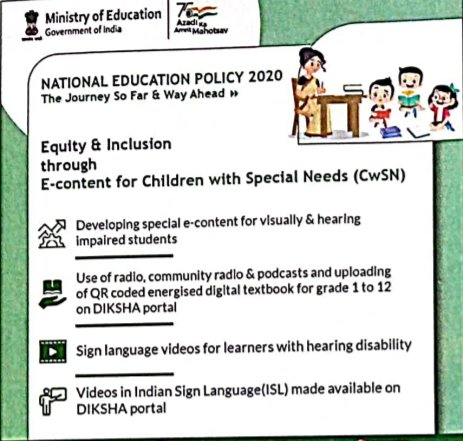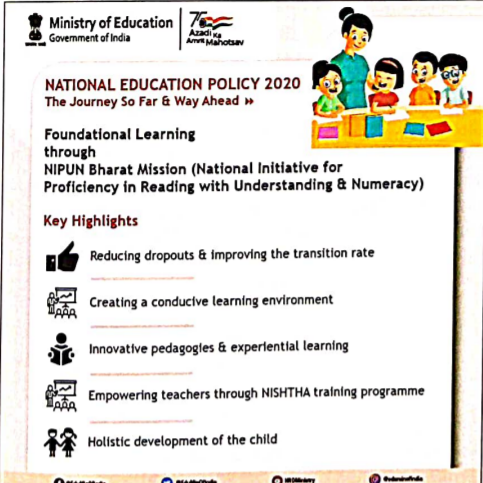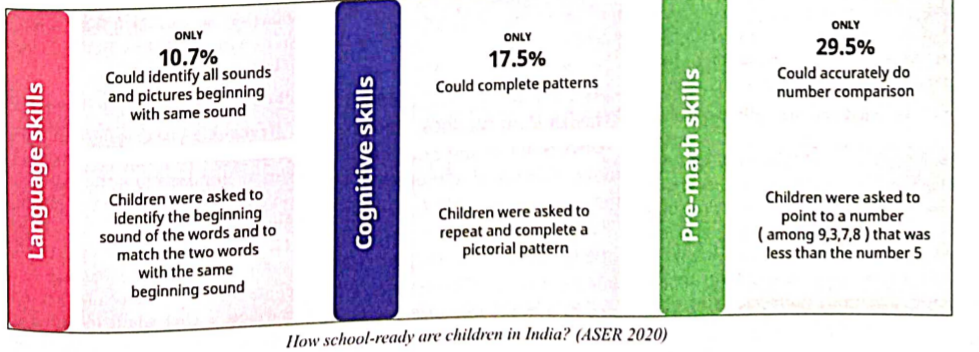Chapter 1: NEP-2020: Dreams and Roadmaps
A new education policy for 2020
NEP-2020 is an all-encompassing plan for the country’s education system. It starts at the elementary level and goes all the way up to college.
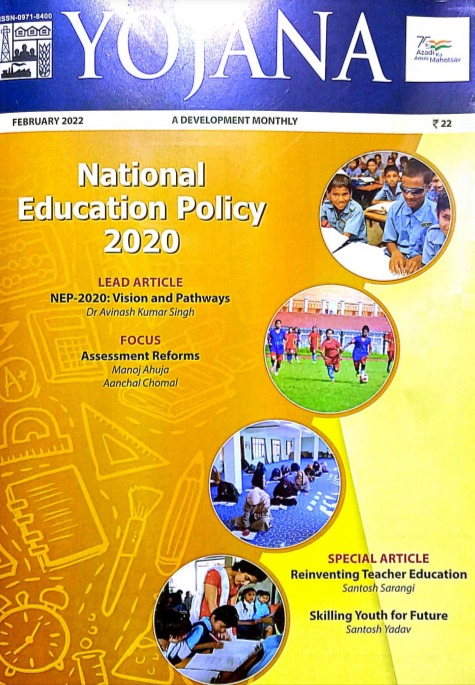
A new policy on education will be put in place of the one from 1986.
It shows what India’s new education system should look like.
NEP 2020 has five pillars: Affordability, Accessibility, Quality, Equity, and Accountability – all of which help students keep learning.
New Education Policy has a very specific goal in mind. +
+
1. Universalisation of Education:
The New Education Policy (NEP) 2020 wants to make sure that everyone can go to school from preschool to high school.
NEP-2020 has a goal of having 100% of all students in school by 2030. This is called the Gross Enrollment Ratio (GER).
2. Curricular and Pedagogical Changes
School curricula will be changed to a 5+3+3+4 structure for ages 3-8, 8-11, 11-14, and 14-18.
This structure, when broken down into the right grades, looks like this:
Three years of anganwadi, or preschool, and two years of primary school in grades 1 and 2 cover the ages of 3 to 8.
The “preparatory stage” is from the ages of 8 to 11 years, or grades 3 to 5.
The “middle stage” is from ages 11 to 14 or grades 6-8.
It’s called the “secondary stage,” and it lasts from ages 14 to 18. There are two parts to it: grades 9-10 and grades 11-12.
3. Equity and Inclusion in Education
The National Education Policy (NEP) 2020 wants everyone to get an equal and inclusive education.
The National Education Plan 2020 says that high dropout rates are found in the poorest and most vulnerable groups.
Inclusion of new Pedagogical system for Early Child Care Education
Inclusive education in Early Childhood Development settings has been found to be the most equitable way for all children to learn for the rest of their lives.
To help young children reach their full potential in cognitive and social-emotional-ethical areas of development, this system should be used at home and in the classroom.
Standard Setting and Accreditation for School and Higher Education
Setting standards for public and private schools is one way NEP 2020 wants to make sure that all stages of education are well-regulated and controlled.
As a way to make sure that all schools meet certain minimum standards for both professional and quality, the States and UTs will set up an independent, state-wide body called the State School Standards Authority (SSSA).
Vocational Education
Vocational Education NEP 2020 makes sure that middle and high school students get a chance to learn about jobs before they go to college, and that mainstream education isn’t thrown out of the window.
It hopes that by 2025, at least 50 percent of people who go to school and college will have had some experience with vocational education.
Chapter 2: Assessment Reforms
Context:
The National Education Policy (the NEP 2020) focuses on how to improve assessments and how to change board exams, which is a step in the right direction.
New Education Policy 2020 (NEP-2020): Assessment Reforms
NEP-2020 wants to change how students are assessed so that they can learn and grow the best they can.
NEP-2020 focuses on regular, formative, and competency-based assessments, which help students learn and grow, and tests for higher-order skills.
The goal of NEP-2020 is to change the way people think about assessment.
NEP 2020 says that India needs to do census checks in certain grades.
The recently approved National Education Policy (NEP 2020) proposes a low-stakes annual school exam for grades 3, 5, and 8 in all public and private schools. This exam would measure how well students learned core concepts, higher-order skills, and how they used them.
A competency-based framework for evaluating skills
NEP 2020 says that progress cards and board exams should be redesigned to make them easier to read and less stressful for students. It also encourages testing core skills to cut down on the need for coaching classes.
Establishing a national testing centre
Proposals to set up a national assessment centre are important because they keep an eye on the education system. They call this centre PARAKH (Performance Assessment, Review, and Analysis of Knowledge for Holistic Development).
Principles of a Good Assessment System:
- Getting everyone on the same page
- Agreement among the stakeholders on what are the core and most important skills.
- The goal is to make the stakeholders aware.
- Ongoing training in different parts of assessment
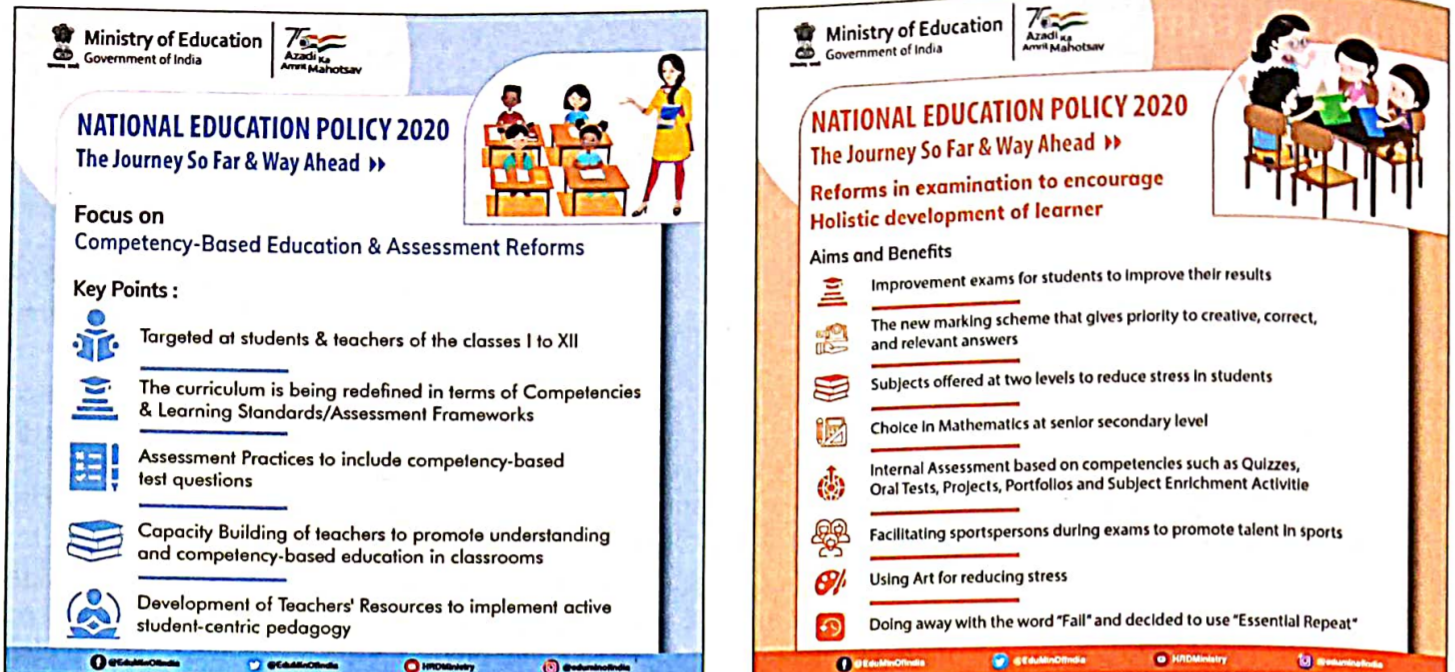
Chapter 3: Changing the way teachers are taught.
The National Education Policy says that teachers and faculty are the heart of the learning process. Teacher education is very important for students to have a wide range of perspectives and knowledge.
An educational, research, and training programme for people who want to teach from pre-school to college level.
Why do we need to change the way we teach?
Skills like analysis and evaluation are important for educators to teach their students in order for them to be able to think critically in the modern world.
Many of the skills we value as 21st-century skills are important for students to learn.
Students now don’t just read their textbooks to learn, and they’re much more aware of what they’re learning. So, the teacher here needs to go beyond the book.
Educators need to be more professional in how they treat students and parents, how they control and manage the classroom environment, and how they deal with other people in the classroom.
Challenges:
It’s not using the most up-to-date science and technology to help students learn how to be good teachers.
Lack of control over teacher education institutions: There are so many teacher education institutions that it is hard to keep track of them all. The quality of some of these places is being sacrificed for the sake of making more money.
Teacher education is memory-based, which means that there is no active involvement from students, so there is a lack in the development of life skills in the students. These skills are important for the all-around development of students.
Teacher education has no planned co-curricular activities, and there are not enough of them. Sometimes, because of a lack of time management, these things aren’t done.
Problem of teaching practise: Teaching practise is not good enough or done correctly. As a student-teacher, he doesn’t take his job seriously.
Teachers’ education after the NEP 2020:
The National Policy in Education was made to improve the quality of education in the country and to make sure that all of the citizens of the country could go to school.
The new policy for education must help get the best and brightest people into teaching at all levels.
Recommendations:
Teachers should be able to teach and learn in a global context, and the NEP recommends Continuous Professional Development for this (CPD).
We always recommend that students keep growing in a step-by-step way, like we do for them. This is always long-term and far-reaching.
Because teachers are worth a lot, the General Education Council should be able to use the National Professional Standards set for teachers both in rural areas and cities to judge their worth.
The teachers who work in schools in rural India should be able to do the same things as their counterparts in cities.
Many of us still think of teaching as a “alternative” job, so we need to be given a lot of hard training so that we can do our best for the future citizens of the country.
Conclusion:
There is a need to change how the Bachelor of Education course is taught and learned, taking into account the multidisciplinary and integrated nature of the curriculum.
One of the main goals of NEP is to help and support teachers through all stages of their jobs.
READ ALSO: YOJANA SUMMARY JANUARY 2022
Chapter 4: Preparing Young People for a Better Tomorrow
A lot of programmes, growth, and development are being done to get young people involved. The government has been very proactive in taking steps to make sure the country’s future is what it wants to be.
A way to do this is to teach young people how to start revolutions, which can be done through policies like the National Education Policy.
Through Vocational Training, we’re trying to help India become more skilled.
Under the Samagra Shiksha Abhiyan, a lot of schools have been built with the goal of educating and skill-training a lot of kids at an early age in a whole lot of different ways.
The use of vocational education has grown a lot in the last six years.
CBSE also thinks that vocational training is an important part of a complete education.
Courses offered by the CBSE also give schools and students a lot of options when it comes to taking competency-based courses.
What are the challenges?
- Perceived social class hierarchy in vocational education
- Lack of ways to move up and down
- All levels of education aren’t integrated into the main education system. There aren’t enough vocational training institutions.
- Narrow the curriculum
- An unsuitable medium of instruction, a lack of faculty to teach the students, and a lack of attention to new areas of industrial development.
- Having the right infrastructure is not good enough
What are the main goals?
By 2025, the New Education Policy 2020 wants to make vocational education a part of both schools and universities for 50% of students.
There must be a focus on the child in any intervention that deals with vocational education.
Vocational education has been tried to be age-appropriate and tailored to each student’s needs at the Primary, Secondary, and High School levels.
As part of the National Skills Qualification Framework, vocational subjects are added to the school curriculum.
In the linked article, you can learn more about the National Skills Qualification Framework, which is how people get jobs.
There is a link between technology and education:
During the pandemic, the use of technology in education has become more important. This has led to a growing need for digital infrastructure to spread skill education.
The use of Artificial Intelligence in education has been a good thing that needs to be expanded on, as well as the reduction of the digital divide in India through effective policy changes.
Towards a more sustainable world:
Keeping up with the changes in society and the economy means that skill education needs to be stepped up. This will help students, businesses, and communities all grow together.
Benjamin Franklin said, “An investment in knowledge pays the best interest.” This means that every policy about education should think about how Benjamin Franklin thought.
Chapter 5: Quality Education for All
Background:
The New Education Policy 2020 wants to change everything about how people learn and teach.
Including quality in education isn’t just important for measuring how efficient it is. It’s also a good way to change the system and open up new opportunities.
The value of good education:
In order for learning to be holistic, integrated, inclusive, fun, and engaging, you need good education.
I think it will help with critical thinking and creativity and scientific temper and communication and so on and so forth and so on and so forth.
Quality education can be a way to move away from a traditional “teach-centered” approach to one that “learns-centered,” which will help students find their own unique talents.
Initiatives taken:
To promote quality education and access in the disadvantaged and weaker sections of society, the national and state governments have taken active initiatives through example schemes including as the Sarva Shiksha Abhiyan (SSA), Rashtriya Madhyamik Shiksha Abhiyan, and Teacher Education.
The Act of 2009 on Children’s Right to Free and Compulsory Education: The standards and rules of the Act must be followed by good quality primary education. In the linked article, learn more about the RTE Act.
NISHTHA (National Initiative for School Heads’ and Teachers’ Holistic Advancement) is a one-of-a-kind programme under Samagra Shiksha through which the government is attempting to reform the teacher training process with the support of major academic institutions.
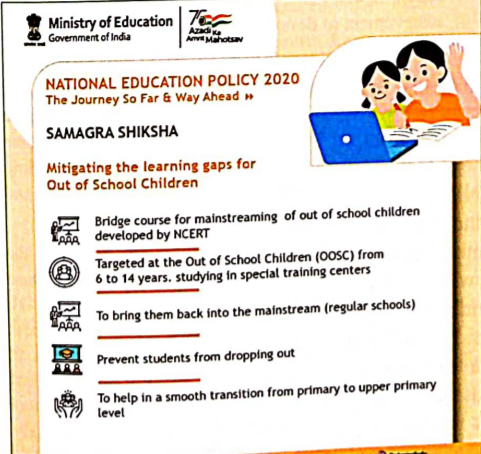
PM eVidya is worth mentioning since it intends to provide access to a variety of e-resources in 33 languages, including Indian Sign Language, DIKSHA (one digital platform), Swayam Prabha, and Podcasts. Shiksha Vani is a Hindu goddess who lives in India.
PM POSHAN Shakti Nirman is a non-profit organisation dedicated to the empowerment of women. It is a federally funded programme that provides nutritious food to Balvatika to class VIII students in government and government-aided schools.
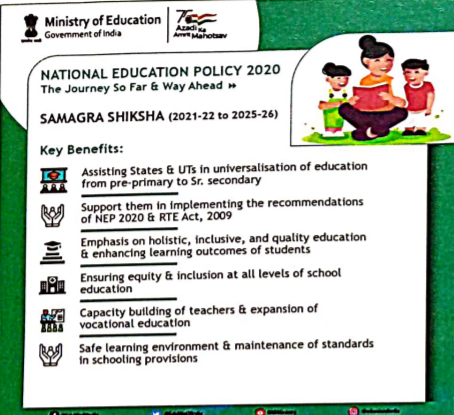
Structured Assessment for Analyzing Learning Level (SAFAL), in compliance with the NEP, will be used to introduce a competency-based assessment for grades 3, 5, and 8.
For Kendriya Vidyalayas, Navodaya Vidyalayas, Private Independent Schools, and Government schools affiliated to the Board, the School Quality Assessment and Accreditation has been considered the Standards Setting Authority.
Recommendations from the New Education Policy 2020 to improve education:
It says that the curricular framework should be changed into a 5+3+3+4 pedagogical and curricular structure.
A pre-vocational education class will start in high school, along with the universalization of Early Childhood Care and Education as well as the basic skills of literacy or math that all kids need to learn.
Planning for good education includes the following:
- Curricular Materials
- Linkages across levels of school education
- Synergy
- Innovative Pedagogy
- Assessment
- Capacity building and Teacher Training
Towards a Long-Term Future:
The government is taking more and more steps to improve the quality of education in schools, which show that they are paying more attention.
A look at how the government is taking steps to make sure that the Sustainable Development Goal for Education is met shows new policies, support for multilingualism, a push for research, innovation, and other skill development programmes (SDG 4).
Chapter 6: Fair and Inclusive Education
People who go to school should be included and have a good chance of getting a good job.
The National Education Policy, 2020, wants to make sure that children with disabilities are included and have the same opportunities as everyone else in elementary and early childhood education and the school system.
In the current NCERT (National Council of Educational Research and Training) books, there are chapters, poems, notes for teachers, and questions for students to answer about how well they did.
To help teachers use inclusive and equitable methods of learning, the NCERT also publishes handouts for teachers to help them do so.
In the linked article, you can learn more about how digital education is used in India.
Barkhaa: Reading for “all” kids.
In the beginning, the Barkhaa Reading series came from the Department of Elementary Education at the NCERT.
It wants to make reading a way of life for the students and make it a habit for them.
Towards a more inclusive world:
Experts say that even though the government and important academic institutions have made a lot of efforts, the idea of inclusion in the educational system still has a long way to go and needs more research and effective policy changes.
People who work in education in the country can add to the success stories if they work together well. This includes teachers, educators, administrators, and policymakers.
This will help to solve the problem of disabilities in children, which makes it hard for them to get a good education and pushes them to take advantage of every chance that comes their way. Thus, the fact that there is an inclusive society will show up in the real world.
Chapter 7: The Nipun Bharat Mission
Background:
Foundational learning is very important to how well students learn in the next grades. There are a lot of benefits to foundational learning, but the main ones are better learning outcomes and more economic growth.
It focuses on how well the kids can read and understand and apply basic math concepts in real life.
It is the goal of NIPUN BHARAT to help people.
This mission is focused on making sure that everyone learns the basics of literacy and math.
This will allow every child to learn the skills they need in reading, writing, and math in the next five years.
The mission’s goals:
Good health for the children (Goal 1), effective communication skills for the children (Goal 2), and making the children interested in their surroundings (Goal 3) are all part of holistic learning (Goal 3).
- Enhancement of skills
- Learning outcomes that are useful
- Including all the people who have a stake in the project
- Reforming the way that learning is measured
Vidya Pravesh wants to make it easier for kids to get Early Childhood Care and Education so they can get used to the classroom.
The Way Forward:
Because of the success of the policies that have been put in place and the active participation of all the stakeholders, now is the right time to promote foundational learning with attention. This would be a big step in the right direction for learning methods in the country.
So, it is hoped that the NIPUN Bharat Mission will be a big step forward in learning that will benefit and shape this country’s future.
Chapter 8: Connecting Education and People
Context:
Culture, knowledge, and standards are all talked about in the relationship between schools and the community.
It’s important for schools to get help from the community to teach kids.
NEP 2020 wants to make sure that all religions are treated with the same level of respect. It also wants to bring back or develop creative human endeavours that are needed for the 21st-century education system.
Community involvement and mobilisation are important factors in the success of adult literacy programmes, along with political will, organisational structure, enough money, and so on.
Education for the whole community.
In higher education, community service is important.
The higher education system should have a wide range of institutions of higher learning that offer undergraduate and graduate programmes, as well as high-quality teaching, research, and community service.
Strong government initiatives for higher education are needed to make it easier for people to get involved in the community and make it easier and more beneficial to use technology.
Some of the issues and limitations:
When some groups are excluded from community-wide projects because of their gender or ethnicity or age, they may not be able to participate fully in these projects because of this.
A lot of people live in communities where power structures have been built up for a long time. These structures can be seen in places like schools, where they can be seen as authoritarian, corrupt, and lacking in transparency.
Communities that get a lot of help from outside groups (religious, humanitarian, or governmental) may develop a learned helplessness or apathy about taking action to solve community problems.
Contributors to Sustained Poverty: Illiteracy, a lack of money or resources, and poor health are some of the things that make it hard for people in a community to participate in educational programmes.
Dependence on External Resources: Communities that rely on outside resources to reach their goals may not be able to sustain community involvement in education programmes in the long run.
READ ALSO: YOJANA SUMMARY DECEMBER 2021
Chapter 9: Getting teachers hired, training them, and evaluating them.
Context:
Better strategies for hiring and deploying teachers can help achieve the Sustainable Development Goal (SDG) 4 of making sure everyone has access to high-quality education.
NEP 2020 and Teacher Recruitment
The National Education Policy 2020 places teachers at the heart of the most important changes in the education system.
The new education policy proposes ways to get the best and brightest people to become teachers at every level.
The teacher must pass the TET, give a demonstration class, pass the interview, and be able to speak the local language to be hired by a private or government school.
All teachers who teach at all four new stages of school education will now have the same tests, called Teacher Eligibility Tests (TETs), to make sure they are qualified to teach. This is what the NEP 2020 says.
There will also be a look at the TET and NTA test scores for the subject teachers when they are hired.
The NEP 2020 also encourages school complexes to hire local eminent people or experts as “master instructors” in a variety of subjects to meet the need for teachers to teach the new classical languages and vocational and skill subjects that have been added to schools.
Training:
In 2020, teachers will be taught how to teach basic literacy and numeracy. They will also be encouraged and helped with their professional development.
Based on the recommendations of NEP 2020, a National Curriculum Framework for Teacher Education, NCFTE 2021, will be written to guide all teacher education. This framework will be called the National Curriculum Framework for Teacher Education.
The B.Ed. degree will cover a wide range of knowledge and pedagogy and give students a lot of practise.
Independent Wing:
People who know how to teach could be hired as trainers for the teacher-training programme.
These trainers will teach the best teachers in each district how to do their job better. When these teachers are done, they can go on to teach other teachers from their district, tehsil, or block level.
This can be done at the SCERT training wing in the states and UTs.
Merit-based Assessment:
Teachers will be hired through rigorous and transparent processes. Promotions will be based on performance, and there will be a mechanism for multi-source periodic performance evaluations and options to become educational administrators or teacher educators.
People from the National Council for Teacher Education are going to come up with a single set of National Professional Standards for Teachers (NPST) by 2022.
Conclusion:
Guidelines for teacher education programmes will also be made in order to meet the goals of the NEP-2020, which is to change the assessment system by the 2022-23 academic year.
Chapter 10: Teach them young
Context:
India’s new socioeconomic environment is making it more important to standardise high-quality Early Childhood Care and Education (ECCE).
A look at the history of early child care in India:
Beginning with the Kothari Commission Report of 1965-66, ECE became a part of India.
There was the Right to Education Act of 2009, which did not make education a basic right for children between the ages of three and six. It went on from there.
When it comes to a five-year foundational stage of education, NEP 2020 says there will be a three-year ECE phase and the first two years of primary school.
the NEP 2020 and early child care education
The NEP says that 85 percent of a child’s brain grows by the age of 6 and emphasises that the brain needs to be properly cared for and stimulated in the early years of a child’s life.
It says that it is very important for every child to have access to high-quality early childhood care and education (ECCE).
The problems with ECCE:
There hasn’t been a move to change the RTE act to make ECCE a fundamental right. ECCE is being made official through the NEP 2020 policy.
The ECCE implementation framework thought the policy would be more centralising. A national-level curricular and pedagogical framework can’t be used as a “one size fits all” strict framework that all schools must follow.
This is an area that has been overlooked and needs a lot of attention and reform.
The policy doesn’t give workers and teachers who can play a big part in ECCE a very good or hopeful plan for how to get them to do their jobs better.
Improving the ECCE:
Flexible Learning allows students to learn how they are smart, how well they can do things, and how quickly they can learn. They can also learn at their own pace.
When we talk about multifaceted learning, we mean going beyond the traditional focus on the 5Cs: communication skills; critical thinking; creative thinking; collaboration; and character building.
Play-based learning – makes learning fun, pleasurable, and fun for everyone.
Activity-based learning makes sure that students are actively involved with the concepts and materials they are learning about.
Discovery-based learning – encourages people to learn about new things by building on their previous knowledge and experiences.
Conclusion:
Literacy is an important part of children’s growth, and it’s a process that goes on for a long time.
Click Here To READ: OTHER MONTHLY YOJANA SUMMARY FOR UPSC EXAM

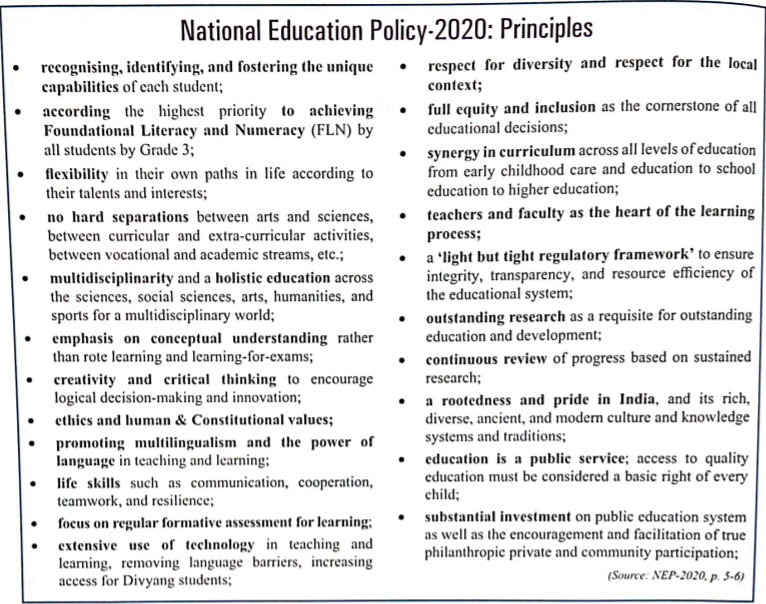 +
+